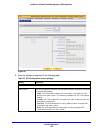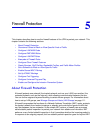
Firewall Protection
130
ProSecure Unified Threat Management (UTM) Appliance
WARNING:
Allowing inbound services opens security holes in your UTM.
Enable only those ports that are necessary for your network.
The following table describes the fields that define the rules for outbound traffic and that are
common to most Outbound Service screens (see Figure 68 on page 141, Figure 71 on
page 144, and Figure 74 on page 147).
The steps to configure outbound rules are described in the following sections:
• Configure LAN WAN Rules
• Configure DMZ WAN Rules
• Configure LAN DMZ Rules
Table 27. Outbound rules overview
Setting Description Outbound Rules
Service
(also referred to as
Service Name)
The service or application to be covered by this rule. If the service or
application does not display in the list, you need to define it using the
Services screen (see Add Customized Services on page 163).
All rules
Action
(also referred to as
Filter)
The action for outgoing connections covered by this rule:
• BLOCK always
• ALLOW always
Note: Any outbound traffic that is not blocked by rules you create is
allowed by the default rule.
Note: ALLOW rules are useful only if the traffic is already covered by
a BLOCK rule. That is, you wish to allow a subset of traffic that is
currently blocked by another rule. Similarly, BLOCK rules are useful
only if the traffic is already covered by an ALLOW rule. That is, you
wish to block a subset of traffic that is currently allowed by another
rule.
All rules
Select Schedule The time schedule that is used by this rule. By default, there is no
schedule assigned (that is, None is selected from the Schedule
drop-down list), and the rule is in effect permanently. For information
about creating schedules, see Set a Schedule to Block or Allow
Specific Traffic on page 177.
All rules


















